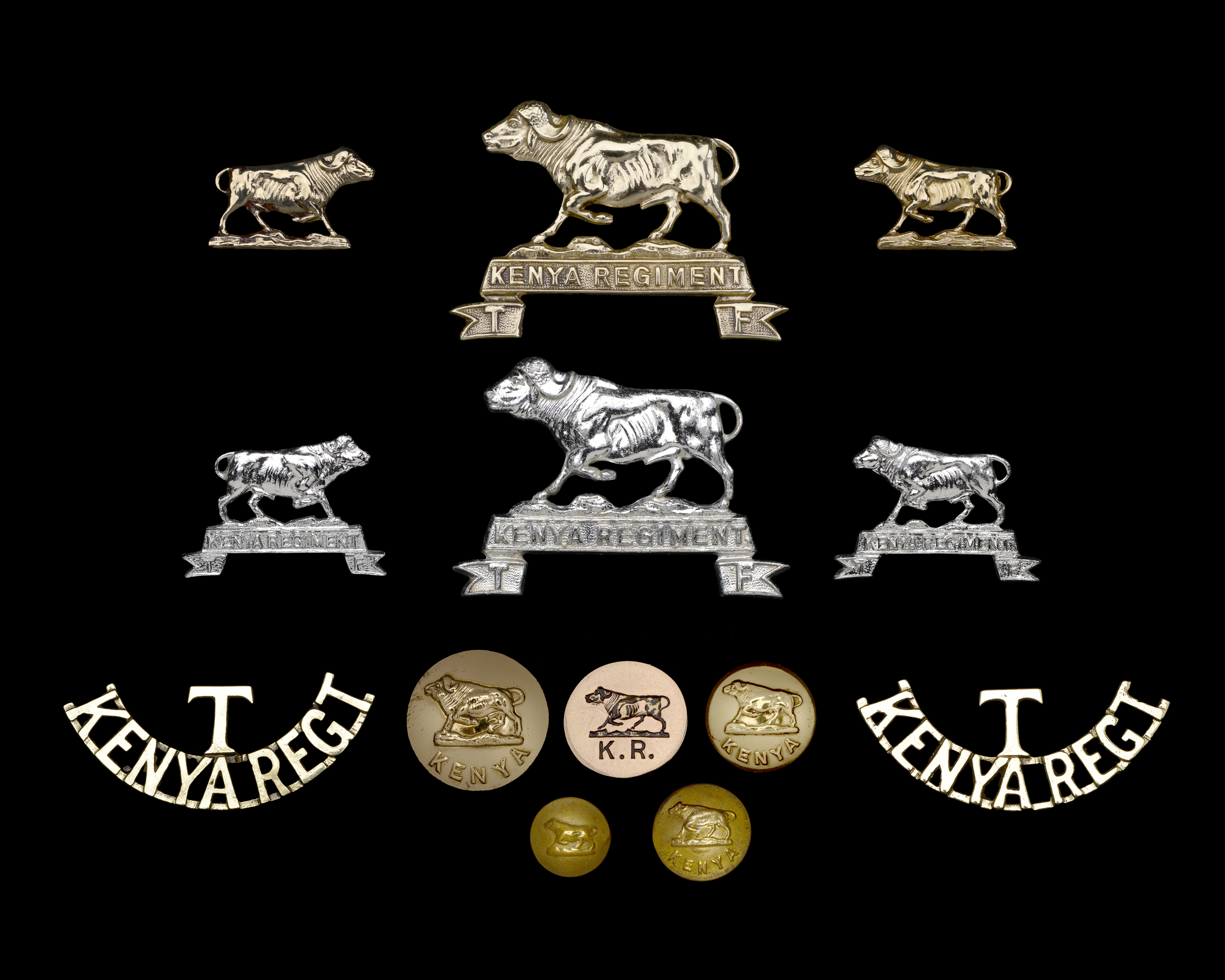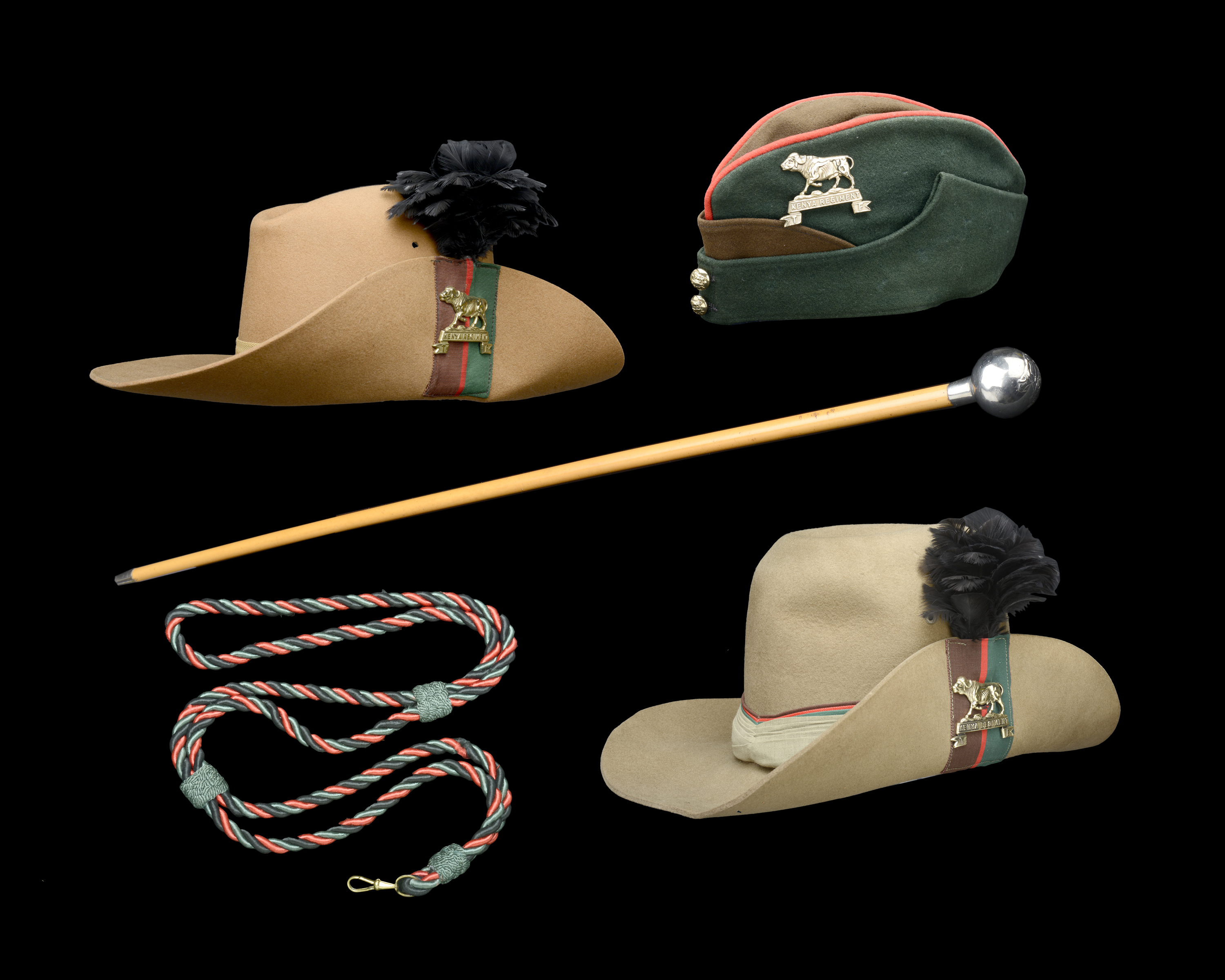
Kenya Regiment Items of Uniform
Michael Schuster

This photograph shows the cap badges, collar dogs and shoulder titles.
The original brass cap badge and collar dogs are at the top showing the earlier collar dogs without the T & F scroll. Brass shoulder titles and buttons are shown at the bottom of the photograph with the officers flat-topped dress button in the centre. The ‘silver’ cap badge and collar dogs were introduced in 1960 following a review by the Dress Committee when Colonel Dick Vernon was Commanding Officer and acknowledging the formal alliance with the King’s Royal Rifle Corps (60th Rifles) in 1956. (From its earliest days, in the eighteenth century, the 60th Rifles cap badge had always been silver.) Also at this time certain other changes were made such as the introduction of black buttons with embossed buffalo on the parade uniform.

This photograph shows a slouch hat, side hat, lanyard and officer’s and NCO’s swagger stick.
The slouch hat is probably the Regiment’s most iconic item of uniform. This was adopted in the early 1940s as formal field-dress head gear instead of the old fashioned, heavier pith helmet or ‘topee’.
The regimental flash with its brown, red and green colours represented respectively: brown for the African askari, red for the permanent staff (largely made up of British Army Guardsmen) who ran the Regiment when it was first formed and trained its soldiers, and green for the country Kenya where the young men who made up the Regiment lived.
The regimental badge of a charging cape buffalo was chosen by some of the Regiment’s very first members. The suggestion of the African bee, by the unit’s first Commanding Officer, Lieutenant Colonel Alfred Dunstan Adams (KR1), was rejected in favour of the buffalo, a decision described as follows by Colonel John Garvey (KR 49) in an article in Buffalo Barua No. 3 (November 2000):
‘Cyril Redhead (KR4), Cecil Valentine (KR5) and others ..... didn’t think much of DA’s suggestion. Finally, so Cyril (who did all the designs) told me, Brigadier Jackie Campbell, commanding Northern Brigade, suggested the buffalo. Cyril drew the designs from the buffalo statuette in the Nairobi club which had been made in memory of the hunter F.C. Selous.’
Cyril Redhead was at the time art master at the Prince of Wales School, Nairobi.
The hackle, made from black ostrich feathers, was adopted when the slouch hat came into use and was that of the King’s African Rifles. It represented the particularly close ties that the Kenya Regiment had with the KAR – a reminder indeed that the original, fundamental concept for the Regiment had been ‘to supply officers, non-commissioned officers, and instructors for the expansion of the King’s African Rifles’ in the event of war. The black hackle was initially that of 1 KAR, dating from 1919, but was adopted by all KAR units following their uniform reorganisation in 1930.
The pagri (Hindi for turban) a turban derived, multi-fold hat band, was a requirement for the original pith helmet, and part of the wartime slouch hats which replaced it, with or without the narrow regimental colour ribbons. The lower slouch hat pictured is from the early 1940s with the broad pagri and colours. It is perhaps the Regiment’s most famous head-dress, that of Colonel Alfred Dunstan Adams (KR1) and is now in the Royal Green Jackets’ Museum in Winchester. The upper slouch hat, with the plain, narrow khaki linen hat band, was standard issue during the 1950s, although the slouch hat with the regimental colours included in the pagri was used as standard parade uniform from the late 1950s until the Regiment was suspended.
The side cap, shown upper right, was also known as a field service cap or fore-and-aft cap, and was worn as being particularly practical, like the subsequent beret, with battledress, though it was by no means limited to the ‘field’. Initially the colour was dark blue and the ‘blue cloth field service cap with regimental badge’ is indicated in the original 1937 Kenya Regiment Ordinance and Regulations as the head dress for ‘Officer’s mess uniform in camp’. Clearly there were also versions, like the one pictured here in the regimental colours, available to order if you could afford to pay for them, as was the case with many regiments of the period. The side cap was eventually replaced, first in the early to mid-1950s, by a dark blue beret, and in the later 1950s by the dark green beret after the formal alliance with the King’s Royal Rifle Corps (60th Rifles) in 1956.
The officer’s and NCO’s swagger stick is silver tipped and silver topped, with the buffalo motif proud on the ball-cap. This one was my father’s, Maj WRF Schuster (KR 1840/3838/5692).
The lanyard pictured was also my father’s. It is made up of black, red and green strands and must have been standard issue. One might have expected that it would have had a brown strand rather than a black one to match the colours of the regimental flash, but I have not come across such an example. All the other lanyards I have seen are also made up of black, red and green strands including the two in the regimental archive, the one belonging to Michael Tremlett (KR4379), those belonging to Colonel Dunstan Adams and those in archive photographs. A significant piece of additional evidence giving the reason why the black, red and green strands were chosen comes from Colonel John Garvey (KR 49) in an article in Buffalo Barua No. 2 (August 1999) where he writes:
‘…the original Kenya Regiment lanyard was a bit of brown cordage, so when we reformed I was given a new lanyard, which I still have, which, I think, was designed by Edward de las Casas [Rifle Brigade, and second-in-command to Lt. Col. C J Valentine when the Regiment was reformed in March 1950]. He had incorporated the green and black of the Rifle Brigade lanyard, with the regimental colours of the 60th Rifles (King’s Royal Rifle Corps) to make a new Kenya Regiment lanyard.
I believe this to be true but I have nothing with which to substantiate what I have written. If supporting evidence is required, I believe that only two people may be able to provide it. One is Teddy Phillips, and the other is Kathleen Dobson [Dunstan Adams’s daughter].’
Most of the PSIs appointed on the reformation of the regiment were from either the Rifle Brigade or the King’s Royal Rifle Corps which adds weight to what John Garvey wrote. There is no mention of a lanyard in the original 1937 Kenya Regiment Ordinance and Regulations about uniforms, though it is very detailed about practically everything else that is uniform related. It seems that prior to the reforming of the Regiment in 1950 there was no ‘multi-coloured’ lanyard, but only a ‘bit of brown cordage’ as Colonel John Garvey mentions, and that Kenya Regiment men were only issued with a lanyard around the time of the Second World War when they were seconded to other units – so that if this was the King’s African Rifles, for example, then they adopted a KAR lanyard.